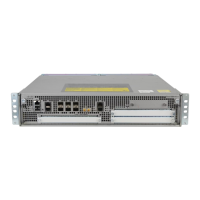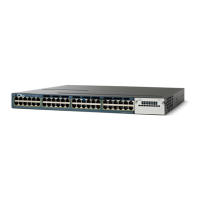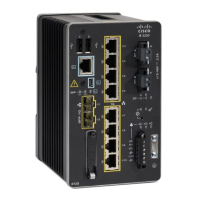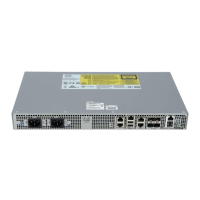

Do you have a question about the Cisco XR 1200 series and is the answer not in the manual?
| Model | XR 1200 series |
|---|---|
| Product Type | Network Router |
| Form Factor | Rack-mountable |
| Operating System | Cisco IOS XR |
| Power Supply | AC or DC options |
| Supported Protocols | BGP, OSPF, MPLS, IPv4/IPv6 |
| Dimensions | Varies depending on the specific model |
| Weight | Varies depending on the specific model |
Lists technical changes made to the document since its first printing.
Provides information on obtaining documentation and submitting service requests via Cisco resources.
Specifies a type of alarm to be suppressed by a logging suppression rule.
Configures a logging suppression rule to suppress all types of alarms.
Applies a logging suppression rule to alarms originating from all locations on the router.
Deletes messages or messages specified by correlation ID from the logging correlator buffer.
Deletes messages from the logging events buffer based on specified criteria.
Resets bi-state alarms messages from the logging events buffer.
Enables context-specific correlation for each context where a given rule is applied.
Applies and activates a correlation rule, entering correlation apply rule configuration mode.
Applies and activates a correlation rule set, entering correlation apply rule set configuration mode.
Configures the size of the logging correlator buffer.
Defines the rules for correlating messages.
Defines a specific correlation rule set.
Configures the size of the logging events buffer.
Enables the alarm source location display field for bistate alarms.
Specifies a severity level for logging alarm messages.
Specifies the logging events buffer threshold that generates an alarm.
Applies and activates a logging suppression rule.
Creates a logging suppression rule and enters configuration mode.
Enters non-root-cause configuration mode and specifies a non-root-cause alarm.
Reissues non-bistate alarm messages after the root-cause alarm clears.
Reparents non-root-cause messages to the next highest active root-cause.
Specifies the root-cause alarm message for a correlation rule.
Displays messages in the logging correlator buffer.
Displays logging correlator buffer size and percentage occupied.
Displays defined correlation rules.
Displays defined correlation rule set names.
Displays messages in the logging events buffer.
Displays configuration and operational information about logging events buffer.
Displays defined logging suppression rules.
Displays messages in the SNMP correlator buffer.
Displays SNMP correlator buffer size and percentage occupied.
Displays defined SNMP correlation rules.
Displays defined SNMP correlation rule set names.
Applies a logging suppression rule to alarms originating from a specific node.
Specifies the collection period duration time for the logging correlator rule message.
Specifies an optional parameter for an applied correlation rule.
Specifies a directory for storing user library files or user-defined EEM policies.
Sets an Embedded Event Manager (EEM) environment variable.
Registers an Embedded Event Manager (EEM) policy with the EEM.
Defines the time between user authentication refreshes in Embedded Event Manager (EEM).
Manually runs an Embedded Event Manager (EEM) policy.
Suspends the Embedded Event Manager (EEM) policy scheduling execution immediately.
Displays the current value of EEM user library files or user-defined policies.
Displays the names and values of EEM environment variables.
Displays EEM reliability data for processes running on a particular node.
Displays EEM reliability metric data for processes.
Displays EEM policies available to be registered.
Displays EEM policies that are already registered.
Displays the time between user authentication refreshes in EEM.
Displays statistic counters maintained by the Statistic Event Detector.
Specifies an access-list name to filter provider edge (PE) addresses for MPLS LSP monitor operations.
Specifies actions performed when configuring the react command or when threshold events occur.
Specifies how long to keep operation in memory when not actively collecting information.
Sets the number of history buckets kept during the lifetime of an IP SLA operation.
Sets the number of hours for which statistics are kept for IP SLA operations.
Specifies the maximum number of buckets for enhanced history statistics.
Disables control packets in IP SLA operations.
Sets the protocol data size in the payload of an operation's request packet.
Identifies the IPv4 address of the target device for an IP SLA operation.
Identifies the port number of the target device for UDP operations.
Sets the number of statistics distributions kept for each hop during an IP SLA operation.
Sets the time interval in milliseconds for each statistical distribution.
Specifies the MPLS experimental field (EXP) value in echo request packet headers.
Defines the type of information kept in the history table for IP SLA operations.
Adds an explicit null label to the label stack of an LSP for echo requests.
Sets the frequency for probing in IP SLA operations.
Configures history parameters for IP SLA operations.
Configures the refresh interval for MPLS label switched path (LSP) monitoring.
Enters IP SLA configuration mode to configure IP Service Level Agreements.
Configures MD5 authentication for IP SLA control messages.
Specifies the length of time to execute an IP SLA operation.
Sets the number of lives maintained in the history table for an IP SLA operation.
Configures the low-memory watermark value for IP SLA.
Specifies the local host IPv4 address used to select an LSP.
Specifies a loose source routing path for ICMP measurement.
Sets the number of hops for statistics maintained for each path in an IP SLA operation.
Sets the number of paths for statistics maintained per hour for an IP SLA operation.
Configures an MPLS LSP monitor instance.
Configures MPLS label switched path (LSP) provider edge (PE) router discovery.
Configures MPLS label switched path (LSP) monitoring.
Configures an IP SLA operation.
Specifies the echo request output interface for LSP ping or trace operations.
Specifies the next-hop address for LSP ping or trace operations.
Specifies the number of packets transmitted during a probe.
Specifies the interval between packets in milliseconds.
Enables path discovery and enters MPLS LSP monitor (MPLSLM) LPD submode.
Configures MPLS LSP echo parameters for path discovery.
Configures MPLS LSP path parameters for MPLSLM LPD submode.
Configures MPLS LSP scan parameters for MPLSLM LPD submode.
Configures MPLS LSP session parameters for MPLSLM LPD submode.
Specifies an element to be monitored for a reaction.
Specifies reaction for LSP Path Discovery (LPD) violation.
Configures MPLS LSP monitoring reactions.
Configures actions based on events controlled by the IP SLA agent.
Defines a second IP SLA operation to transition from pending to active state.
Indicates operation starts automatically at a specified time daily.
Specifies the DSCP value used in echo reply packets.
Specifies how to reply to echo requests.
Specifies frequency for deleting provider edge (PE) routers.
Specifies frequency for MPLS LSP monitor instance to check scan queue.
Schedules MPLS LSP monitoring instances.
Enters schedule configuration mode for IP SLA operations.
Configures time for all LSP operations to start or run.
Displays information for the IP SLA application.
Displays history collected for IP SLA operations.
Displays routing info for BGP next-hop discovery in MPLS VPN.
Displays LSP Path Discovery (LPD) operational status.
Displays BGP next-hop addresses waiting for addition/deletion.
Displays list of operations created automatically by MPLS LSP monitor.
Displays probes handled by active ports on the responder.
Displays hourly statistics for IP SLA operations.
Displays operational data and latest statistics for IP SLA operations.
Displays enhanced history statistics for collected buckets.
Identifies the IPv4 address of the source device.
Identifies the port number of the source device.
Determines the time when an operation or monitor instance starts.
Sets statistics collection parameters for an operation.
Creates a user-specified identifier for an IP SLA operation.
Specifies the IPv4 address of the target router for MPLS LSP ping/trace.
Specifies the pseudowire as the target for an MPLS LSP ping operation.
Specifies the target MPLS traffic engineering tunnel for LSP ping/trace.
Sets the lower-limit and upper-limit values for threshold checking.
Takes action on average values that violate a threshold.
Takes action after a number of consecutive violations.
Takes action immediately upon a threshold violation.
Takes action upon X violations in Y probe operations.
Sets the probe or control timeout interval for IP SLA operations.
Sets the type of service (ToS) in a probe packet.
Specifies the time-to-live (TTL) value in the MPLS label of echo request packets.
Configures the ICMP echo operation type.
Configures the ICMP path-echo operation type.
Configures the ICMP path-jitter operation type.
Verifies end-to-end LSP connectivity and MPLS network integrity.
Traces LSP paths and localizes network faults in an MPLS network.
Configures the UDP echo operation type.
Configures a permanent port in IP SLA responder for UDP operations.
Configures the UDP jitter operation type.
Checks each IP SLA response for corruption.
Configures VRF table for non-default VPN routing for IP SLA operations.
Specifies VRF for monitoring in MPLS LSP monitor ping or trace operations.
Specifies the length of time logs are maintained in the logging archive.
Specifies the amount of space allotted for syslogs on a device.
Clears system logging (syslog) messages from the logging buffer.
Specifies the device to be used for logging syslogs.
Specifies the maximum file size for a log file in the logging archive.
Specifies the collection period for logs (daily or weekly).
Specifies a system logging (syslog) server host as the recipient of syslog messages.
Configures attributes for archiving syslogs.
Specifies the logging buffer as a destination for system logging (syslog) messages.
Enables logging of syslog messages to the console by severity level.
Disables logging of system logging (syslog) messages to the console.
Enables logging of link-status messages for logical and physical links.
Enables logging of link-status messages on a specific interface.
Configures the type of syslog facility for sending syslog messages.
Changes the severity level of syslog messages sent to the history table.
Changes the number of syslog messages stored in the history table.
Appends a hostname prefix to syslog messages.
Specifies the size of the local logging file.
Specifies terminal lines as destinations for syslog messages and limits them by severity.
Sets the IP address of an interface as the source IP address for all messages.
Prevents logging of messages indicating deprecated commands.
Prevents consecutive logging of the same syslog message.
Specifies the severity level of messages logged to syslog servers.
Modifies the time-stamp format for syslog and debug messages.
Specifies the filter level for logs.
Displays the contents of the logging buffer.
Displays information about the state of the syslog history table.
Enables display of debug output and syslog messages for the current terminal session.
Clears OBFL logging messages from a node or from all nodes.
Enables or disables onboard failure logging (OBFL).
Displays onboard failure logging (OBFL) messages.
Monitors controller fabric counters in real time.
Monitors SONET controller counters.
Monitors interface counters in real time.
Applies a statistics template to gather samples for a particular instance.
Applies a statistics template and enables statistics collection.
Applies a threshold template and enables threshold collection.
Applies a defined regular expression group to statistics or threshold templates.
Configures the local filesystem for dumping statistics data.
Configures memory consumption limits for performance management.
Configures a destination TFTP server for PM statistics collections.
Creates a template for collecting performance management statistics.
Configures a template for threshold checking.
Displays PM data from BGP entity instance monitoring or statistics collections.
Displays PM data from interface entity instance monitoring or statistics collections.
Displays PM data for MPLS entity instance monitoring or statistics collections.
Displays PM data for node entity monitoring or statistics collections.
Displays PM data for OSPF entity instance monitoring or statistics collections.
Displays configured templates and the template being applied.
Clears the interface counters.
Specifies the interval for load calculation of an interface.











